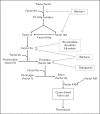Perioperatively acquired disorders of coagulation
- PMID: 25734869
- PMCID: PMC4418784
- DOI: 10.1097/ACO.0000000000000176
Perioperatively acquired disorders of coagulation
Abstract
Purpose of review: To provide an overview of acquired coagulopathies that can occur in various perioperative clinical settings. Also described are coagulation disturbances linked to antithrombotic medications and currently available strategies to reverse their antithrombotic effects in situations of severe hemorrhage.
Recent findings: Recent studies highlight the link between low fibrinogen and decreased fibrin polymerization in the development of acquired coagulopathy. Particularly, fibrin(ogen) deficits are observable after cardiopulmonary bypass in cardiac surgery, on arrival at the emergency room in trauma patients, and with ongoing bleeding after child birth. Regarding antithrombotic therapy, although new oral anticoagulants offer the possibility of efficacy and relative safety compared with vitamin K antagonists, reversal of their anticoagulant effect with nonspecific agents, including prothrombin complex concentrate, has provided conflicting results. Specific antidotes, currently being developed, are not yet licensed for clinical use, but initial results are promising.
Summary: Targeted hemostatic therapy aims to correct coagulopathies in specific clinical settings, and reduce the need for allogeneic transfusions, thus preventing massive transfusion and its deleterious outcomes. Although there are specific guidelines for reversing anticoagulation in patients treated with antiplatelet agents or warfarin, there is currently little evidence to advocate comprehensive recommendations to treat drug-induced coagulopathy associated with new oral anticoagulants.
Figures



References
-
- Ragni MV. The old and new: PCCs, VIIa, and long-lasting clotting factors for hemophilia and other bleeding disorders. Hematology Am Soc Hematol Educ Program 2013; 2013:44–51. - PubMed
-
- Muszbek L, Yee VC, Hevessy Z. Blood coagulation factor XIII: structure and function. Thromb Res 1999; 94:271–305. - PubMed
-
- Solomon C, Rahe-Meyer N. In reply. Transfusion 2013; 53:1138–1140. - PubMed
-
- Blome M, Isgro F, Kiessling AH, et al. Relationship between factor XIII activity, fibrinogen, haemostasis screening tests and postoperative bleeding in cardiopulmonary bypass surgery. Thromb Haemost 2005; 93:1101–1107. - PubMed
Publication types
MeSH terms
Substances
LinkOut - more resources
Full Text Sources
Medical
Research Materials

